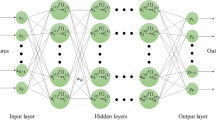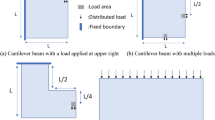Abstract
Grid-stiffened structures are widely used in industrial equipment, where the layout of stiffener unit cells is critical in the structural performance. However, owing to the lack of design techniques, existing stiffener unit cell designs are often achieved only by comparative selection among several common cell configurations. In this study, a deep learning-based intelligent optimization framework for the stiffener unit cell of grid-stiffened panels was proposed. First, a database containing nearly 10,000 stiffener unit cells was generated by traversal while considering the manufacturability. Feature extraction was then performed on the generated database using a variational autoencoder and mapped to a 16-dimensional continuous latent design space according to geometric features. Subsequently, in this latent space, a Gaussian process model was established, and the maximum expected improvement criterion was utilized to drive the model update and optimization search, thus realizing data-driven optimization for the stiffener unit cell of grid-stiffened panels. In three typical numerical examples, compared with the best of the traditional stiffener unit cells, the obtained optimal designs were improved by 25.61%, 25.88%, and 10.66%, respectively, demonstrating the effectiveness of this method as an alternative stiffener unit cell design method. Furthermore, this study also indicates the significant potential of geometric feature extraction and further structural layout optimization via deep learning.






















Similar content being viewed by others
References
Bendsøe MP, Sigmund O (1999) Material interpolation schemes in topology optimization. Arch Appl Mech 69(9):635–654
Christensen PW, Klarbring A (2008) An Introduction to structural optimization. Springer, New York
Doersch (2016) Tutorial on variational autoencoders. arXiv preprint arXiv:1606.05908
Dugré A, Vadean A (2016) Chausse. Challenges of using topology optimization for the design of pressurized stiffened panels. Struct Multidisc Optim 53(2):303–320
Gao J, Gao L, Luo Z, Li P (2019) Isogeometric topology optimization for continuum structures using density distribution function. Int J Numer Methods Eng 119(10):991–1017
Gao J, Wang L, Luo Z, Gao L (2021) IgaTop: an implementation of topology optimization for structures using IGA in MATLAB. Struct Multidisc Optim 64(3):1669–1700
Goodfellow I, Bengio Y, Courville A (2016) Deep learning. MIT Press, Cambridge
Haftka RT, Gürdal Z (1992) Elements of structural optimization. Springer, New York
Han ZH, Zhang KS (2012) Surrogate-based optimization. In: Roeva O (ed) Real-world applications of genetic algorithms, InTech, pp 343–362
Hao P, Wang B, Li G (2012) Surrogate-based optimum design for stiffened shells with adaptive sampling. AIAA J 50(11):2389–2407
Hao P, Wang B, Li G, Meng Z, Tian K, Tang X (2014) Hybrid optimization of hierarchical stiffened shells based on smeared stiffener method and finite element method. Thin-Walled Struct 82:46–54
Hao P, Wang Y, Liu C, Wang B, Tian K, Li G, Wang Q, Jiang L (2018) Hierarchical nondeterministic optimization of curvilinearly stiffened panel with multicutouts. AIAA J 56(10):4180–4194
Hao P, Liu D, Zhang K, Yuan Y, Wang B, Li G, Zhang X (2021) Intelligent layout design of curvilinearly stiffened panels via deep learning-based method. Mater Design 197:109180
Hershey JR, Olsen PA (2007) Approximating the Kullback Leibler divergence between Gaussian mixture models. In: 2007 IEEE International Conference on Acoustics, Speech and Signal Processing-ICASSP'07. IEEE, 2007, vol 4, pp IV-317–IV-320
Huybrechts S, Meink TE (1997) Advanced grid stiffened structures for the next generation of launch vehicles. In: 1997 IEEE Aerospace Conference, vol 1, pp 263–270
Jackson PC (2019) Introduction to artificial intelligence. Courier Dover Publications, Mineola
Jones DR, Schonlau M, Welch WJ (1998) Efficient global optimization of expensive black-box functions. J Glob Optim 13(4):455–492
Kingma DP, Welling M (2013) Auto-encoding variational bayes. arXiv preprint arXiv:1312.6114
Lanzi L, Giavotto V (2006) Post-buckling optimization of composite stiffened panels: computations and experiments. Compos Struct 73(2):208–220
Larsen ABL, Sønderby SK, Larochelle H, Winther O (2015) Autoencoding beyond pixels using a learned similarity metric. arXiv:1512.09300
Li R, Wang S, Long Z, Gu D (2018) Undeepvo: monocular visual odometry through unsupervised deep learning. In: 2018 IEEE international conference on robotics and automation (ICRA), pp 7286–7291
Li S, Wei H, Yuan S, Zhu J, Zhang W (2021) Collaborative optimization design of process parameter and structural topology for laser additive manufacturing. Chin J Aeronaut
Liao Z, Wang Y, Gao L, Wang ZP (2022) Deep-learning-based isogeometric inverse design for tetra-chiral auxetics. Compos Struct 280:114808
Lim KH, Li X, Guan ZD (2013) Optimal design of advanced grid stiffened composite cylindrical shell. Appl Mech Mater 330:681–686
Liu D, Hao P, Zhang K, Tian K, Wang B, Li G, Xu W (2020) On the integrated design of curvilinearly grid-stiffened panel with non-uniform distribution and variable stiffener profile. Mater Design 190:108556
Noor AK, Venneri SL, Paul DB, Hopkins MA (2000) Structures technology for future aerospace systems. Comput Struct 74(5):507–519
Oune N, Bostanabad R (2021) Latent map Gaussian processes for mixed variable metamodeling. Comput Methods Appl Mech Eng 387:114128
Park C, Haftka RT, Kim NH (2017) Remarks on multi-fidelity surrogates. Struct Multidisc Optim 55(3):1029–1050
Raissi M, Perdikaris P, Karniadakis GE (2019) Physics-informed neural networks: a deep learning framework for solving forward and inverse problems involving nonlinear partial differential equations. J Comput Phys 378:686–707
Seo J, Kapania RK (2022) Development of deep convolutional neural network for structural topology optimization. In: AIAA SCITECH 2022 Forum. 2351
Timoshenko SP, Gere JM (2009) Theory of elastic stability. Dover Publications, Mineola
Walker M (2002) The effect of stiffeners on the optimal ply orientation and buckling load of rectangular laminated plates. Comput Struct 80(27–30):2229–2239
Wang B, Hao P, Li G, Tian K, Du K, Wang X, Zhang X, Tang X (2014) Two-stage size-layout optimization of axially compressed stiffened panels. Struct Multidisc Optim 50(2):313–327
Wang B, Tian K, Hao P, Cai YW, Li YW, Sun Y (2015) Hybrid analysis and optimization of hierarchical stiffened plates based on asymptotic homogenization method. Compos Struct 132(11):136–147
Wang B, Tian K, Hao P, Zheng Y, Ma Y, Wan J (2016) Numerical-based smeared stiffener method for global buckling analysis of grid-stiffened composite cylindrical shells. Compos Struct 152:807–815
Wang B, Tian K, Zhou C, Hao P, Zheng Y, Ma Y, Wang J (2017) Grid-pattern optimization framework of novel hierarchical stiffened shells allowing for imperfection sensitivity. Aerosp Sci Technol 62:114–121
Wang D, Yeo SY, Su Z, Wang ZP, Abdalla MM (2020a) Data-driven streamline stiffener path optimization (SSPO) for sparse stiffener layout design of non-uniform curved grid-stiffened composite (NCGC) structures. Comput Meth Appl Mech Eng 365:113001
Wang L, Chan YC, Ahmed F, Liu Z, Zhu P, Chen W (2020b) Deep generative modeling for mechanistic-based learning and design of metamaterial systems. Comput Methods Appl Mech Engrg 372:113377
Wang L, Beek A, Da D, Chan YC, Zhu P, Chen W (2022) Data-driven multiscale design of cellular composites with multiclass microstructures for natural frequency maximization. Compos Struct 280:114949
Wang X, Guo W (2016) Dynamic modeling and vibration characteristics analysis of submerged stiffened combined shells. Ocean Eng 127:226–235
Yang Z, Li X, Brinson LC, Choudhary AN, Chen W, Agrawal A (2018) Microstructural materials design via deep adversarial learning methodology. J Mech Des 140(11):111416
Zegard T, Paulino GH (2014) GRAND–Ground structure based topology optimization for arbitrary 2D domains using MATLAB. Struct Multidisc Optim 50(5):861–882
Zhang Y, Tao S, Chen W, Apley DW (2020) A latent variable approach to Gaussian process modeling with qualitative and quantitative factors. Technometrics 62(3):291–302
Zhao Y, Chen M, Yang F, Zhang L, Fang D (2017) Optimal design of hierarchical grid-stiffened cylindrical shell structures based on linear buckling and nonlinear collapse analyses. Thin-Walled Struct 119:315–323
Zhou H, Zhu J, Wang C, Zhang Y, Wang J, Zhang W (2022) Hierarchical structure optimization with parameterized lattice and multiscale finite element method. Struct Multidisc Optim 65(1):1–20
Zhu JH, Zhang WH, Xia L (2016) Topology optimization in aircraft and aerospace structures design. Arch Comput Method Eng 23(4):595–622
Acknowledgements
This work was supported by the National Key Research and Development Program of China (2021YFF0306404), National Natural Science Foundation of China (U21A20429 and 11825202), and LiaoNing Revitalization Talents Program (XLYC1907142).
Author information
Authors and Affiliations
Corresponding author
Ethics declarations
Conflict of interest
On behalf of all authors, the corresponding author states that there is no conflict of interest.
Replication of results
The details of the proposed methodology and of the specific values of the parameters considered have been provided in the paper. Hence, the results can be reproduced. The main functions of VAE-GAN for feature extraction can be downloaded from the website: https://github.com/xutengfei2000/VAE-GAN-for-feature-extraction/tree/main. However, because the engineering example involves the script-based finite element modeling code of the research group, it is not convenient to show them publicly.
Additional information
Responsible Editor: Ramin Bostanabad
Publisher's Note
Springer Nature remains neutral with regard to jurisdictional claims in published maps and institutional affiliations.
Rights and permissions
Springer Nature or its licensor (e.g. a society or other partner) holds exclusive rights to this article under a publishing agreement with the author(s) or other rightsholder(s); author self-archiving of the accepted manuscript version of this article is solely governed by the terms of such publishing agreement and applicable law.
About this article
Cite this article
Liu, D., Hao, P., Xu, T. et al. Intelligent optimization of stiffener unit cell via variational autoencoder-based feature extraction. Struct Multidisc Optim 66, 8 (2023). https://doi.org/10.1007/s00158-022-03463-y
Received:
Accepted:
Published:
DOI: https://doi.org/10.1007/s00158-022-03463-y














